Conflict Analysis of Auckland Pride Festival: Government & NGO Actions
VerifiedAdded on 2023/04/26
|8
|2144
|268
Essay
AI Summary
This essay analyzes the conflict that occurred during the Auckland Pride Festival, a yearly event celebrating New Zealand's LGBTQI+ community. The essay explores the different aspects involved, including the clash over costumed police officers and the subsequent protests. It examines the contributions and failures of both government and non-governmental organizations (NGOs) in managing the situation, maintaining security, and upholding the rights of the LGBTQI+ community. The essay highlights issues such as police conduct, lack of preparedness, and the failure of NGOs to raise awareness. It also discusses the broader context of discrimination faced by the LGBTQI+ community and the need for equal rights and respect. The analysis aims to critically examine the security-development nexus related to this conflict, drawing on relevant references to support its arguments.
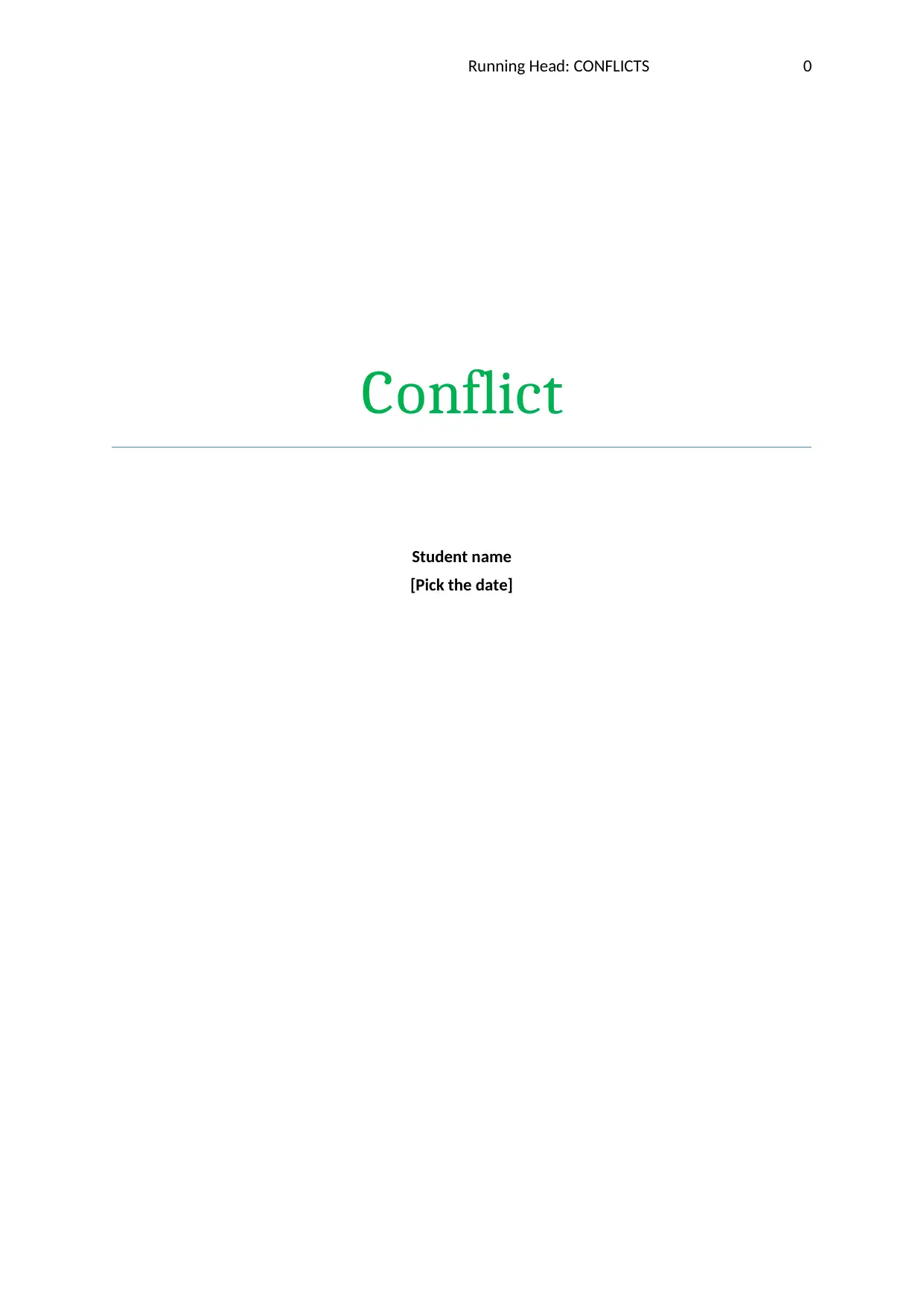
Running Head: CONFLICTS 0
Conflict
Student name
[Pick the date]
Conflict
Student name
[Pick the date]
Paraphrase This Document
Need a fresh take? Get an instant paraphrase of this document with our AI Paraphraser
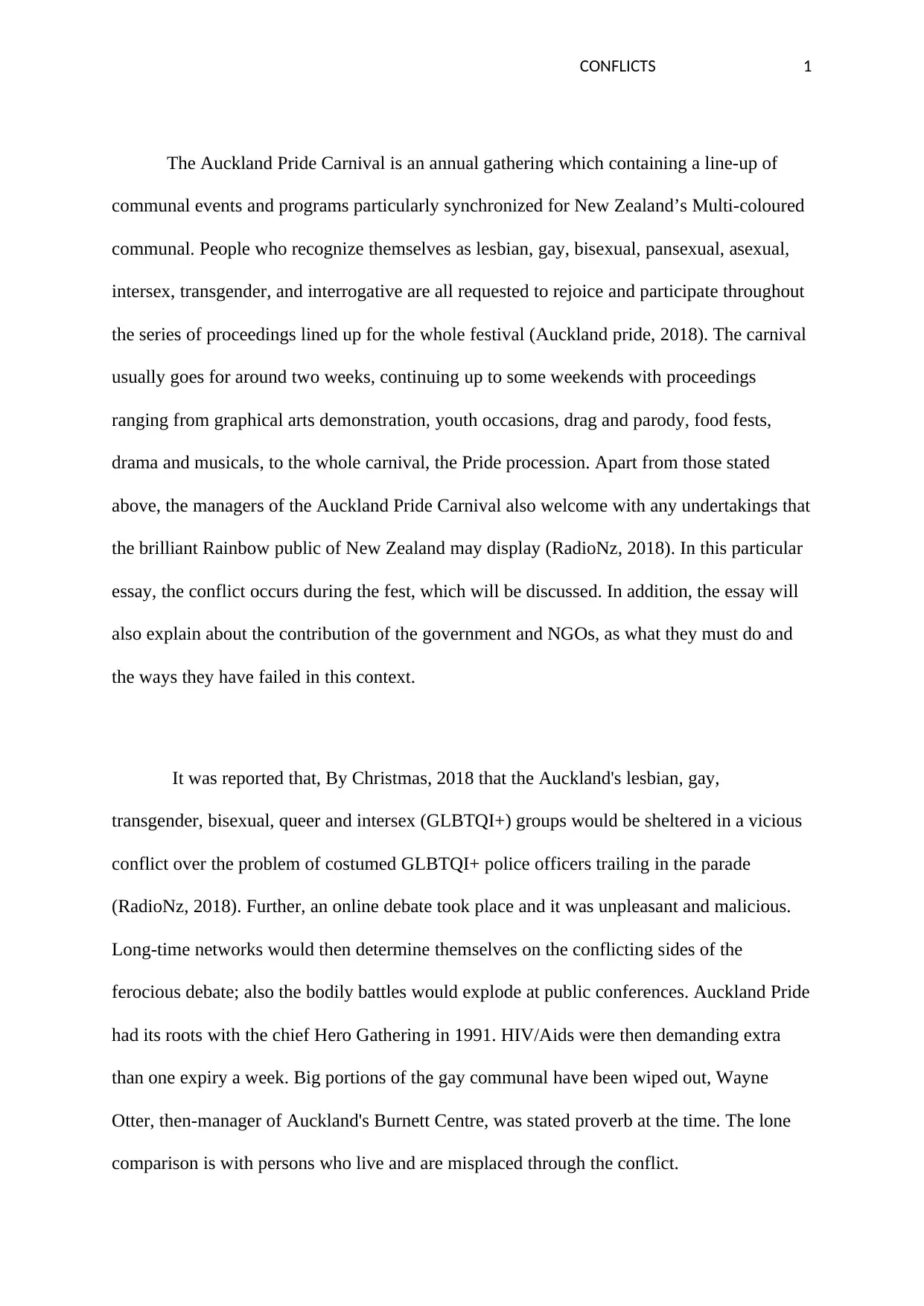
CONFLICTS 1
The Auckland Pride Carnival is an annual gathering which containing a line-up of
communal events and programs particularly synchronized for New Zealand’s Multi-coloured
communal. People who recognize themselves as lesbian, gay, bisexual, pansexual, asexual,
intersex, transgender, and interrogative are all requested to rejoice and participate throughout
the series of proceedings lined up for the whole festival (Auckland pride, 2018). The carnival
usually goes for around two weeks, continuing up to some weekends with proceedings
ranging from graphical arts demonstration, youth occasions, drag and parody, food fests,
drama and musicals, to the whole carnival, the Pride procession. Apart from those stated
above, the managers of the Auckland Pride Carnival also welcome with any undertakings that
the brilliant Rainbow public of New Zealand may display (RadioNz, 2018). In this particular
essay, the conflict occurs during the fest, which will be discussed. In addition, the essay will
also explain about the contribution of the government and NGOs, as what they must do and
the ways they have failed in this context.
It was reported that, By Christmas, 2018 that the Auckland's lesbian, gay,
transgender, bisexual, queer and intersex (GLBTQI+) groups would be sheltered in a vicious
conflict over the problem of costumed GLBTQI+ police officers trailing in the parade
(RadioNz, 2018). Further, an online debate took place and it was unpleasant and malicious.
Long-time networks would then determine themselves on the conflicting sides of the
ferocious debate; also the bodily battles would explode at public conferences. Auckland Pride
had its roots with the chief Hero Gathering in 1991. HIV/Aids were then demanding extra
than one expiry a week. Big portions of the gay communal have been wiped out, Wayne
Otter, then-manager of Auckland's Burnett Centre, was stated proverb at the time. The lone
comparison is with persons who live and are misplaced through the conflict.
The Auckland Pride Carnival is an annual gathering which containing a line-up of
communal events and programs particularly synchronized for New Zealand’s Multi-coloured
communal. People who recognize themselves as lesbian, gay, bisexual, pansexual, asexual,
intersex, transgender, and interrogative are all requested to rejoice and participate throughout
the series of proceedings lined up for the whole festival (Auckland pride, 2018). The carnival
usually goes for around two weeks, continuing up to some weekends with proceedings
ranging from graphical arts demonstration, youth occasions, drag and parody, food fests,
drama and musicals, to the whole carnival, the Pride procession. Apart from those stated
above, the managers of the Auckland Pride Carnival also welcome with any undertakings that
the brilliant Rainbow public of New Zealand may display (RadioNz, 2018). In this particular
essay, the conflict occurs during the fest, which will be discussed. In addition, the essay will
also explain about the contribution of the government and NGOs, as what they must do and
the ways they have failed in this context.
It was reported that, By Christmas, 2018 that the Auckland's lesbian, gay,
transgender, bisexual, queer and intersex (GLBTQI+) groups would be sheltered in a vicious
conflict over the problem of costumed GLBTQI+ police officers trailing in the parade
(RadioNz, 2018). Further, an online debate took place and it was unpleasant and malicious.
Long-time networks would then determine themselves on the conflicting sides of the
ferocious debate; also the bodily battles would explode at public conferences. Auckland Pride
had its roots with the chief Hero Gathering in 1991. HIV/Aids were then demanding extra
than one expiry a week. Big portions of the gay communal have been wiped out, Wayne
Otter, then-manager of Auckland's Burnett Centre, was stated proverb at the time. The lone
comparison is with persons who live and are misplaced through the conflict.

CONFLICTS 2
Ponson by Rd held the parade for a second time, with a projected audience of 30,000
persons that increased year by year. The Pride Carnival featured art demonstrations, theatre
presentations, a dog demonstration, a writer's carnival, and the well-attended large gay out at
Coyle Country Park in point chevalier. GLBTQI+ police department officers had been
trooping in the parade ever since the year 2013 wearing police uniform with the help of their
seniors from 2015 (Express, 2017). Their existence was received with cheers by the people
and canned as an indication of the changing era. Then campaigners from an assembly then
recognized as No Pride in Prisons (NPIP), currently Pride against Prisons Aotearoa (PAPA),
initiated joining the parade as activists, not contestants (Ex press, 2018). They were
concentrated on the dealing and sexual forcefulness that certain Trans women practice when
they are retained in male jails. Though, the very existence of the GLBTQI+ associates of the
police as the costumed group trooping in the carnival was challenging for the group (The
Guardian, 2018).
The voting of a novel Pride panel in 2018 meant a renewed strategy. The fresh
chairperson, Cissy Rock, was an administrative inventor with a 20-year past of working on
planned solutions for communal and government assemblies. After a month, there were four
public Hui, counting one online, detained by Auckland Pride, to access the form of the
events. Consequently, in initial November 2018, the panel publicized that whereas they
greeted GLBTQI+ police generals parading in the carnival in 2019, they would not be wanted
to march in the uniform as they also had done meanwhile 2015, and no cooperation has been
conveyed. GLBTQI+ police removed from the occasion; while permitting for an upcoming
arrangement. Almost instantaneously, the New Zealand Security Force supposed it would
shadow suit. Private businesses began reconsidering their participation (Ex press, 2017). In
2014, the initial year that police department officers trooped in the carnival, Māori were 7.1
times additional likely to be targets of one of these practices of police forcefulness, Rākete
Ponson by Rd held the parade for a second time, with a projected audience of 30,000
persons that increased year by year. The Pride Carnival featured art demonstrations, theatre
presentations, a dog demonstration, a writer's carnival, and the well-attended large gay out at
Coyle Country Park in point chevalier. GLBTQI+ police department officers had been
trooping in the parade ever since the year 2013 wearing police uniform with the help of their
seniors from 2015 (Express, 2017). Their existence was received with cheers by the people
and canned as an indication of the changing era. Then campaigners from an assembly then
recognized as No Pride in Prisons (NPIP), currently Pride against Prisons Aotearoa (PAPA),
initiated joining the parade as activists, not contestants (Ex press, 2018). They were
concentrated on the dealing and sexual forcefulness that certain Trans women practice when
they are retained in male jails. Though, the very existence of the GLBTQI+ associates of the
police as the costumed group trooping in the carnival was challenging for the group (The
Guardian, 2018).
The voting of a novel Pride panel in 2018 meant a renewed strategy. The fresh
chairperson, Cissy Rock, was an administrative inventor with a 20-year past of working on
planned solutions for communal and government assemblies. After a month, there were four
public Hui, counting one online, detained by Auckland Pride, to access the form of the
events. Consequently, in initial November 2018, the panel publicized that whereas they
greeted GLBTQI+ police generals parading in the carnival in 2019, they would not be wanted
to march in the uniform as they also had done meanwhile 2015, and no cooperation has been
conveyed. GLBTQI+ police removed from the occasion; while permitting for an upcoming
arrangement. Almost instantaneously, the New Zealand Security Force supposed it would
shadow suit. Private businesses began reconsidering their participation (Ex press, 2017). In
2014, the initial year that police department officers trooped in the carnival, Māori were 7.1
times additional likely to be targets of one of these practices of police forcefulness, Rākete
⊘ This is a preview!⊘
Do you want full access?
Subscribe today to unlock all pages.

Trusted by 1+ million students worldwide
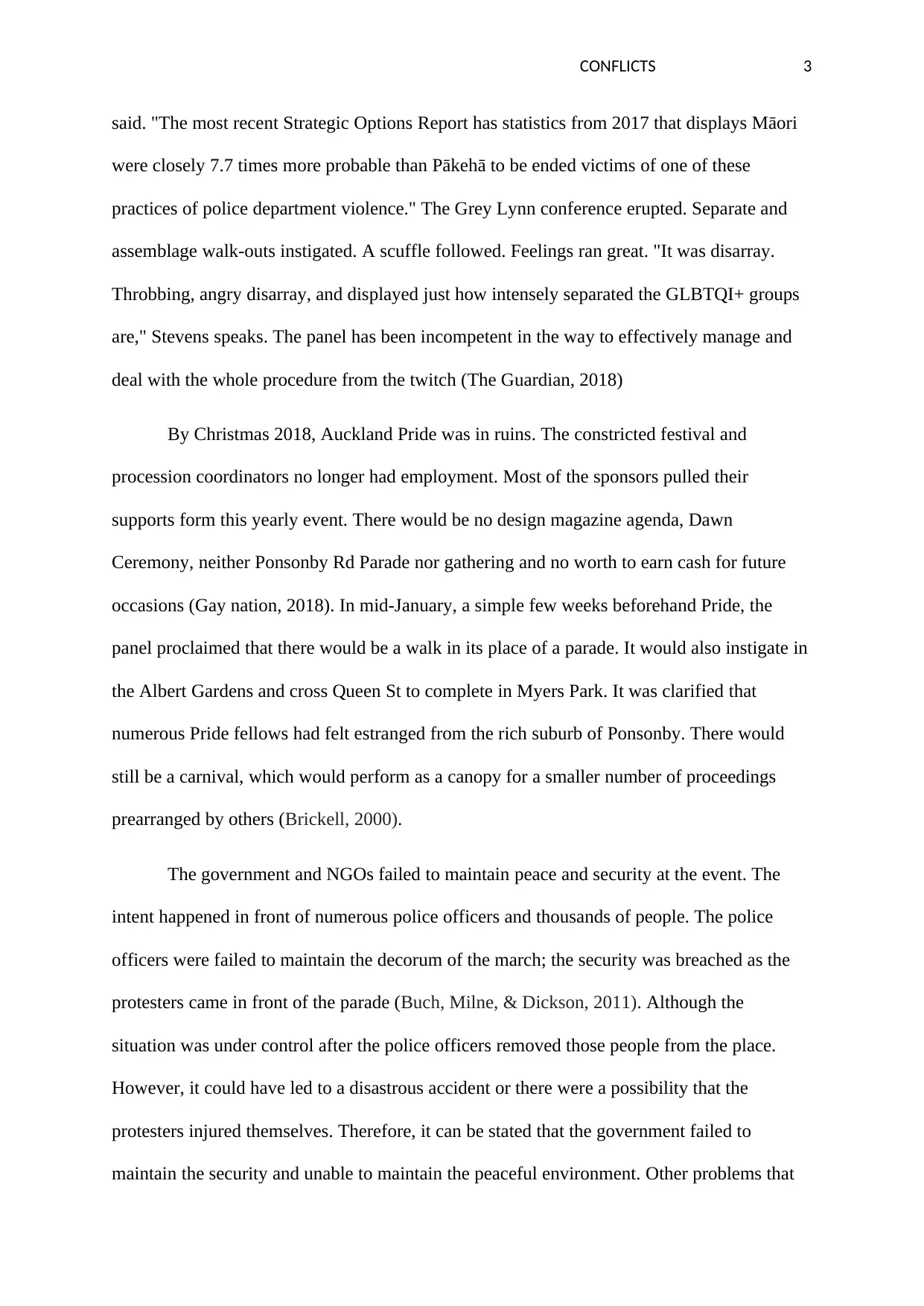
CONFLICTS 3
said. "The most recent Strategic Options Report has statistics from 2017 that displays Māori
were closely 7.7 times more probable than Pākehā to be ended victims of one of these
practices of police department violence." The Grey Lynn conference erupted. Separate and
assemblage walk-outs instigated. A scuffle followed. Feelings ran great. "It was disarray.
Throbbing, angry disarray, and displayed just how intensely separated the GLBTQI+ groups
are," Stevens speaks. The panel has been incompetent in the way to effectively manage and
deal with the whole procedure from the twitch (The Guardian, 2018)
By Christmas 2018, Auckland Pride was in ruins. The constricted festival and
procession coordinators no longer had employment. Most of the sponsors pulled their
supports form this yearly event. There would be no design magazine agenda, Dawn
Ceremony, neither Ponsonby Rd Parade nor gathering and no worth to earn cash for future
occasions (Gay nation, 2018). In mid-January, a simple few weeks beforehand Pride, the
panel proclaimed that there would be a walk in its place of a parade. It would also instigate in
the Albert Gardens and cross Queen St to complete in Myers Park. It was clarified that
numerous Pride fellows had felt estranged from the rich suburb of Ponsonby. There would
still be a carnival, which would perform as a canopy for a smaller number of proceedings
prearranged by others (Brickell, 2000).
The government and NGOs failed to maintain peace and security at the event. The
intent happened in front of numerous police officers and thousands of people. The police
officers were failed to maintain the decorum of the march; the security was breached as the
protesters came in front of the parade (Buch, Milne, & Dickson, 2011). Although the
situation was under control after the police officers removed those people from the place.
However, it could have led to a disastrous accident or there were a possibility that the
protesters injured themselves. Therefore, it can be stated that the government failed to
maintain the security and unable to maintain the peaceful environment. Other problems that
said. "The most recent Strategic Options Report has statistics from 2017 that displays Māori
were closely 7.7 times more probable than Pākehā to be ended victims of one of these
practices of police department violence." The Grey Lynn conference erupted. Separate and
assemblage walk-outs instigated. A scuffle followed. Feelings ran great. "It was disarray.
Throbbing, angry disarray, and displayed just how intensely separated the GLBTQI+ groups
are," Stevens speaks. The panel has been incompetent in the way to effectively manage and
deal with the whole procedure from the twitch (The Guardian, 2018)
By Christmas 2018, Auckland Pride was in ruins. The constricted festival and
procession coordinators no longer had employment. Most of the sponsors pulled their
supports form this yearly event. There would be no design magazine agenda, Dawn
Ceremony, neither Ponsonby Rd Parade nor gathering and no worth to earn cash for future
occasions (Gay nation, 2018). In mid-January, a simple few weeks beforehand Pride, the
panel proclaimed that there would be a walk in its place of a parade. It would also instigate in
the Albert Gardens and cross Queen St to complete in Myers Park. It was clarified that
numerous Pride fellows had felt estranged from the rich suburb of Ponsonby. There would
still be a carnival, which would perform as a canopy for a smaller number of proceedings
prearranged by others (Brickell, 2000).
The government and NGOs failed to maintain peace and security at the event. The
intent happened in front of numerous police officers and thousands of people. The police
officers were failed to maintain the decorum of the march; the security was breached as the
protesters came in front of the parade (Buch, Milne, & Dickson, 2011). Although the
situation was under control after the police officers removed those people from the place.
However, it could have led to a disastrous accident or there were a possibility that the
protesters injured themselves. Therefore, it can be stated that the government failed to
maintain the security and unable to maintain the peaceful environment. Other problems that
Paraphrase This Document
Need a fresh take? Get an instant paraphrase of this document with our AI Paraphraser
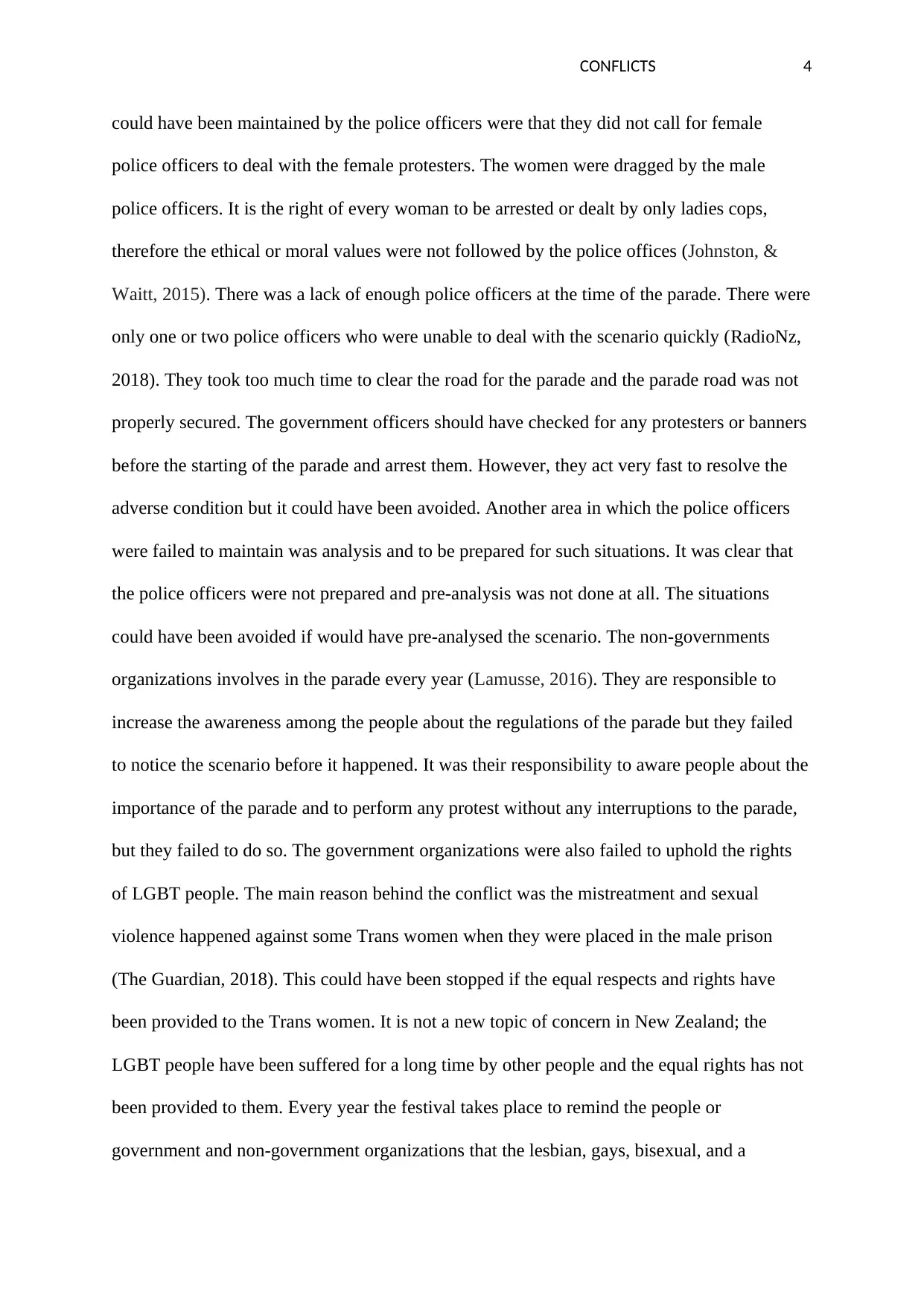
CONFLICTS 4
could have been maintained by the police officers were that they did not call for female
police officers to deal with the female protesters. The women were dragged by the male
police officers. It is the right of every woman to be arrested or dealt by only ladies cops,
therefore the ethical or moral values were not followed by the police offices (Johnston, &
Waitt, 2015). There was a lack of enough police officers at the time of the parade. There were
only one or two police officers who were unable to deal with the scenario quickly (RadioNz,
2018). They took too much time to clear the road for the parade and the parade road was not
properly secured. The government officers should have checked for any protesters or banners
before the starting of the parade and arrest them. However, they act very fast to resolve the
adverse condition but it could have been avoided. Another area in which the police officers
were failed to maintain was analysis and to be prepared for such situations. It was clear that
the police officers were not prepared and pre-analysis was not done at all. The situations
could have been avoided if would have pre-analysed the scenario. The non-governments
organizations involves in the parade every year (Lamusse, 2016). They are responsible to
increase the awareness among the people about the regulations of the parade but they failed
to notice the scenario before it happened. It was their responsibility to aware people about the
importance of the parade and to perform any protest without any interruptions to the parade,
but they failed to do so. The government organizations were also failed to uphold the rights
of LGBT people. The main reason behind the conflict was the mistreatment and sexual
violence happened against some Trans women when they were placed in the male prison
(The Guardian, 2018). This could have been stopped if the equal respects and rights have
been provided to the Trans women. It is not a new topic of concern in New Zealand; the
LGBT people have been suffered for a long time by other people and the equal rights has not
been provided to them. Every year the festival takes place to remind the people or
government and non-government organizations that the lesbian, gays, bisexual, and a
could have been maintained by the police officers were that they did not call for female
police officers to deal with the female protesters. The women were dragged by the male
police officers. It is the right of every woman to be arrested or dealt by only ladies cops,
therefore the ethical or moral values were not followed by the police offices (Johnston, &
Waitt, 2015). There was a lack of enough police officers at the time of the parade. There were
only one or two police officers who were unable to deal with the scenario quickly (RadioNz,
2018). They took too much time to clear the road for the parade and the parade road was not
properly secured. The government officers should have checked for any protesters or banners
before the starting of the parade and arrest them. However, they act very fast to resolve the
adverse condition but it could have been avoided. Another area in which the police officers
were failed to maintain was analysis and to be prepared for such situations. It was clear that
the police officers were not prepared and pre-analysis was not done at all. The situations
could have been avoided if would have pre-analysed the scenario. The non-governments
organizations involves in the parade every year (Lamusse, 2016). They are responsible to
increase the awareness among the people about the regulations of the parade but they failed
to notice the scenario before it happened. It was their responsibility to aware people about the
importance of the parade and to perform any protest without any interruptions to the parade,
but they failed to do so. The government organizations were also failed to uphold the rights
of LGBT people. The main reason behind the conflict was the mistreatment and sexual
violence happened against some Trans women when they were placed in the male prison
(The Guardian, 2018). This could have been stopped if the equal respects and rights have
been provided to the Trans women. It is not a new topic of concern in New Zealand; the
LGBT people have been suffered for a long time by other people and the equal rights has not
been provided to them. Every year the festival takes place to remind the people or
government and non-government organizations that the lesbian, gays, bisexual, and a

CONFLICTS 5
transgender also have the same rights as normal people. No matter how the government
organizations pretend to show that the LGBT people also have the same rights as the
common people, but the truth is that the LGBT people are still being discriminated in
different parts of the country. They are still looking for equality and respect in different areas.
If the NGOs do their work properly and increase the awareness, then this type of incidents
will not be occurring in the future (Knowledge Auckland. 2017).
The pride festival of Auckland is a yearly public gathering comprised of different
events and programs. The festival focuses specifically on lesbians, gays, bisexual, and
transgender. The LGBTI people have been facing issues for a long time and still confronting
discrimination in different areas, which sometimes leads to conflict. One of the main conflicts
took place in the fest when a group of 2 to 3 people represented banners in front of the police
parade event. This happened because some of the transgender previously prisoned in the male
prison, and further there was a security breach because of the lack of awareness and
attentiveness of the government and NGOs.
transgender also have the same rights as normal people. No matter how the government
organizations pretend to show that the LGBT people also have the same rights as the
common people, but the truth is that the LGBT people are still being discriminated in
different parts of the country. They are still looking for equality and respect in different areas.
If the NGOs do their work properly and increase the awareness, then this type of incidents
will not be occurring in the future (Knowledge Auckland. 2017).
The pride festival of Auckland is a yearly public gathering comprised of different
events and programs. The festival focuses specifically on lesbians, gays, bisexual, and
transgender. The LGBTI people have been facing issues for a long time and still confronting
discrimination in different areas, which sometimes leads to conflict. One of the main conflicts
took place in the fest when a group of 2 to 3 people represented banners in front of the police
parade event. This happened because some of the transgender previously prisoned in the male
prison, and further there was a security breach because of the lack of awareness and
attentiveness of the government and NGOs.
⊘ This is a preview!⊘
Do you want full access?
Subscribe today to unlock all pages.

Trusted by 1+ million students worldwide
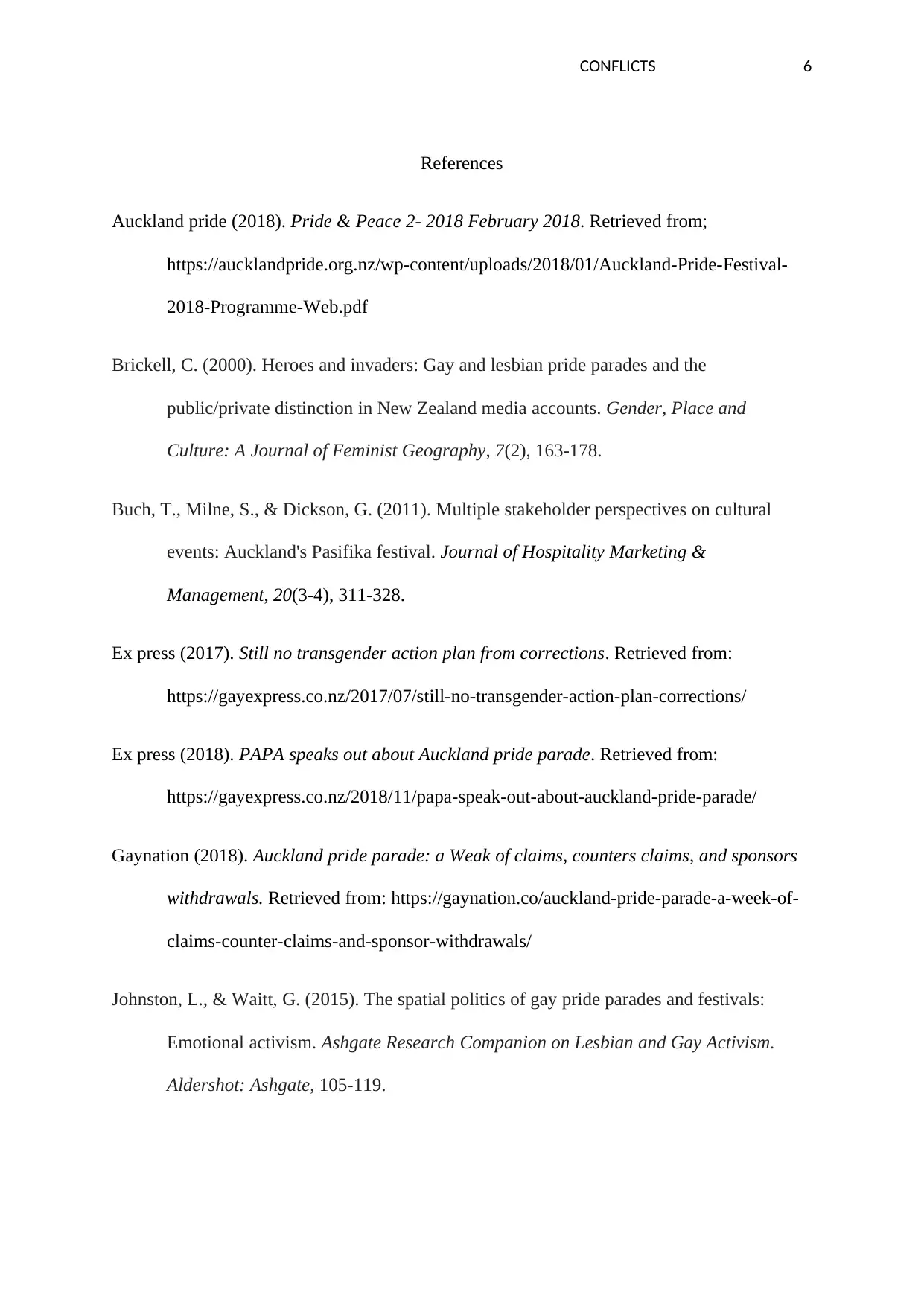
CONFLICTS 6
References
Auckland pride (2018). Pride & Peace 2- 2018 February 2018. Retrieved from;
https://aucklandpride.org.nz/wp-content/uploads/2018/01/Auckland-Pride-Festival-
2018-Programme-Web.pdf
Brickell, C. (2000). Heroes and invaders: Gay and lesbian pride parades and the
public/private distinction in New Zealand media accounts. Gender, Place and
Culture: A Journal of Feminist Geography, 7(2), 163-178.
Buch, T., Milne, S., & Dickson, G. (2011). Multiple stakeholder perspectives on cultural
events: Auckland's Pasifika festival. Journal of Hospitality Marketing &
Management, 20(3-4), 311-328.
Ex press (2017). Still no transgender action plan from corrections. Retrieved from:
https://gayexpress.co.nz/2017/07/still-no-transgender-action-plan-corrections/
Ex press (2018). PAPA speaks out about Auckland pride parade. Retrieved from:
https://gayexpress.co.nz/2018/11/papa-speak-out-about-auckland-pride-parade/
Gaynation (2018). Auckland pride parade: a Weak of claims, counters claims, and sponsors
withdrawals. Retrieved from: https://gaynation.co/auckland-pride-parade-a-week-of-
claims-counter-claims-and-sponsor-withdrawals/
Johnston, L., & Waitt, G. (2015). The spatial politics of gay pride parades and festivals:
Emotional activism. Ashgate Research Companion on Lesbian and Gay Activism.
Aldershot: Ashgate, 105-119.
References
Auckland pride (2018). Pride & Peace 2- 2018 February 2018. Retrieved from;
https://aucklandpride.org.nz/wp-content/uploads/2018/01/Auckland-Pride-Festival-
2018-Programme-Web.pdf
Brickell, C. (2000). Heroes and invaders: Gay and lesbian pride parades and the
public/private distinction in New Zealand media accounts. Gender, Place and
Culture: A Journal of Feminist Geography, 7(2), 163-178.
Buch, T., Milne, S., & Dickson, G. (2011). Multiple stakeholder perspectives on cultural
events: Auckland's Pasifika festival. Journal of Hospitality Marketing &
Management, 20(3-4), 311-328.
Ex press (2017). Still no transgender action plan from corrections. Retrieved from:
https://gayexpress.co.nz/2017/07/still-no-transgender-action-plan-corrections/
Ex press (2018). PAPA speaks out about Auckland pride parade. Retrieved from:
https://gayexpress.co.nz/2018/11/papa-speak-out-about-auckland-pride-parade/
Gaynation (2018). Auckland pride parade: a Weak of claims, counters claims, and sponsors
withdrawals. Retrieved from: https://gaynation.co/auckland-pride-parade-a-week-of-
claims-counter-claims-and-sponsor-withdrawals/
Johnston, L., & Waitt, G. (2015). The spatial politics of gay pride parades and festivals:
Emotional activism. Ashgate Research Companion on Lesbian and Gay Activism.
Aldershot: Ashgate, 105-119.
Paraphrase This Document
Need a fresh take? Get an instant paraphrase of this document with our AI Paraphraser
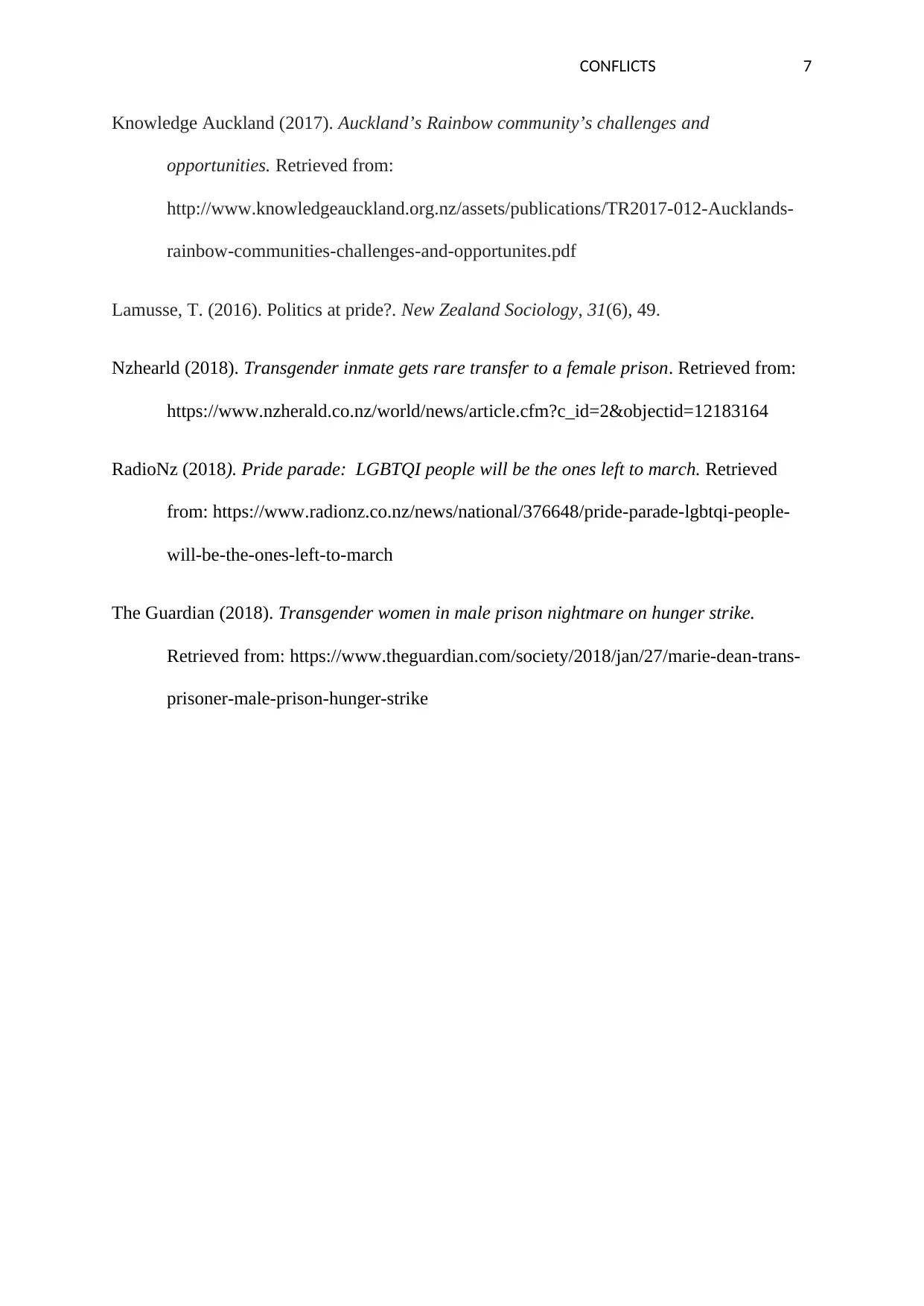
CONFLICTS 7
Knowledge Auckland (2017). Auckland’s Rainbow community’s challenges and
opportunities. Retrieved from:
http://www.knowledgeauckland.org.nz/assets/publications/TR2017-012-Aucklands-
rainbow-communities-challenges-and-opportunites.pdf
Lamusse, T. (2016). Politics at pride?. New Zealand Sociology, 31(6), 49.
Nzhearld (2018). Transgender inmate gets rare transfer to a female prison. Retrieved from:
https://www.nzherald.co.nz/world/news/article.cfm?c_id=2&objectid=12183164
RadioNz (2018). Pride parade: LGBTQI people will be the ones left to march. Retrieved
from: https://www.radionz.co.nz/news/national/376648/pride-parade-lgbtqi-people-
will-be-the-ones-left-to-march
The Guardian (2018). Transgender women in male prison nightmare on hunger strike.
Retrieved from: https://www.theguardian.com/society/2018/jan/27/marie-dean-trans-
prisoner-male-prison-hunger-strike
Knowledge Auckland (2017). Auckland’s Rainbow community’s challenges and
opportunities. Retrieved from:
http://www.knowledgeauckland.org.nz/assets/publications/TR2017-012-Aucklands-
rainbow-communities-challenges-and-opportunites.pdf
Lamusse, T. (2016). Politics at pride?. New Zealand Sociology, 31(6), 49.
Nzhearld (2018). Transgender inmate gets rare transfer to a female prison. Retrieved from:
https://www.nzherald.co.nz/world/news/article.cfm?c_id=2&objectid=12183164
RadioNz (2018). Pride parade: LGBTQI people will be the ones left to march. Retrieved
from: https://www.radionz.co.nz/news/national/376648/pride-parade-lgbtqi-people-
will-be-the-ones-left-to-march
The Guardian (2018). Transgender women in male prison nightmare on hunger strike.
Retrieved from: https://www.theguardian.com/society/2018/jan/27/marie-dean-trans-
prisoner-male-prison-hunger-strike
1 out of 8
Your All-in-One AI-Powered Toolkit for Academic Success.
+13062052269
info@desklib.com
Available 24*7 on WhatsApp / Email
![[object Object]](/_next/static/media/star-bottom.7253800d.svg)
Unlock your academic potential
Copyright © 2020–2025 A2Z Services. All Rights Reserved. Developed and managed by ZUCOL.